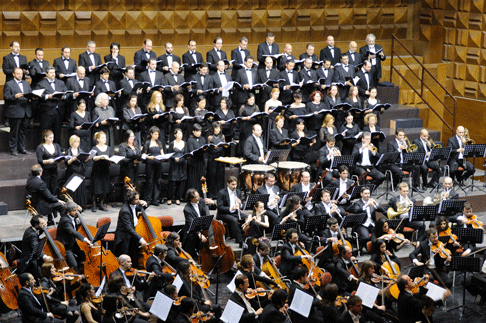Because of different time-zones, Die Schˆpfung day started
in New Zealand and ended in Honolulu. An earnest radio listener could enjoy the
different performances over 24 hours and appreciate the difference in
conducting as well as in singing. Opera houses were included because in certain
countries (e.g. Germany) Die Schˆpfung is also staged as a music
drama: computer technology and animation are a superb support to show the
initial chaos , the creation of the animals, of the flowers, of the lakes, of
the rivers and of the mountain as well as the Eden garden with the passionate
Adam and Eve duet.
In Rome, the Orchestra Sinfonica – Fondazione Roma (OsFr) was selected for
the task. The OsFr is a peculiarity in the Italian musical landscape: it is the
only fully private symphony orchestra. It does not receive any State,
Regional., Provincial or Municipal support but it is financed by the Fondazione
Roma ( a nonprofit foundation) and by a few companies. It has 90 permanent
elements (average age: 30), a budget which is less than one-fifth of that of
the main symphony orchestra in the Italian capital (l’Accademia Nazionale
di Santa Cecilia) and a low- priced ticket policy to attract young and old
people with modest income (season tickets for 30 concerts vary from € 260
to € 90 according to the category). Its music director and permanent
conductor is Maestro Francesco La Vecchia, who is also principal guest
conductor of the Berliner Symphoniker. La Vecchia has been music director of
Opera Houses and symphony orchestras in Central Europe (Budapest), Latin
America (Rio de Janeiro) and Portugal (Lisbon). The OsFr started some eight
years ago after a EU-supported training program for young graduates from
European conservatories. It has gained an important place in the international
music scenes also due to its tournÈe in Germany, Poland and China.
In January, the Accademia di Santa Cecilia had offered a different version
of Die Schˆpfung — performed by Frieburger Barochester conducted
by RenÈ Jacobs and with Julia Kleiter, Donat Havar and Johanner Weisser as
soloists. The difference, of course, is not in the score (both Jacobs and La
Vecchia conducted the full score without cuts or intermission) but in the
style: dry, albeit almost religious, Jacobs’; passionate (even in the
approach to religion) La Vecchia’s .
Die Schˆpfung is well known. Thus, there is no need to provide
Opera Today readers with background on its composition, on its Austrian and
London premiËres and on its contents. Its three parts are operatic acts. In the
first and in the second, the three archangels Gabriel, Uriel and Raphael
observe the Creation by following very closely the biblical text. In the third
act, we are no longer witnessing from a distance the works of the Creator. The
scene is the Eden Garden. After an introduction of Uriel, the act is long love
scene of Adam and Eve that includes a duet supported by a choral background. As
Haydn planned, there are five characters but three singers: the bass and the
soprano are Raphael and Gabriel in the first and second act but become Adam and
Eve in the third act. The roles are taxing both for the duration (nearly two
hours of music ) and for the “virtuoso” singing — they imply
“coloratura”, “agility”, quite a few high Cs and many
Fs.

Maestro La Vecchia recalls that in 1992 he had conducted Die
Schˆpfung in the Amazonian Forest, at the vey confluence of the Rio Branco
with the Rio Petro. Over 10,000 Indios attended the performance thrilled by the
Haydn’s score. Most likely, the memory of that performance influenced
conducting on May 31st. In the first part, it is noteworthy how conductor,
orchestra and singers amplified the transition from the chaos (C minor) to the
newly lit world (A major) . In the second act, the emphasis is on the
descriptive imagery as in the portrayal of the animals: the cheerful, but rude,
trombone blast of the lion, the pouncing tiger, the placing grazing of cattle,
the sinuous music for the worm. The third act is less contemplative than
normally performed: the love between Adam and Eve is powerful, not merely
platonic; their duet is rapturous and timeless, an essential transition to the
glorious final chorus.
La Vecchia and the symphony orchestra had three excellent singers to work
with. Anita Selvaggio is a “soprano assoluto” better known outside
Italy than in her own country. Both as an archangel and as Eve she displayed a a remarkable flexibility in the upper extension and an extraordinary use of
messa di voce (a quality that many sopranos seem neither to care for
nor to practice enough). Michael Smallwood is an up-and-coming Australian tenor
with a delicate sensuous “legato”. David Wilson Johson is the best
known of the three soloists. He once again confirmed his talent and
versatility.
Giuseppe Pennisi (Based On May 31st Rome Symphony Orchestra Performance)
image=http://www.operatoday.com/OSR_Creazione-0717-2.gif
image_description=Anita Selvaggio
product=yes
product_title=F. J. Haydn: Die Schˆpfung (The Creation)
product_by=Anita Selvaggio, Soprano; Michael Smallwood, Tenor; David Wilson Johnson, Bass; London Symphony Chorus. Joseph Cullen, Chorus Master. Francesco La Vecchia, Conductor.
product_id=Above: Anita Selvaggio